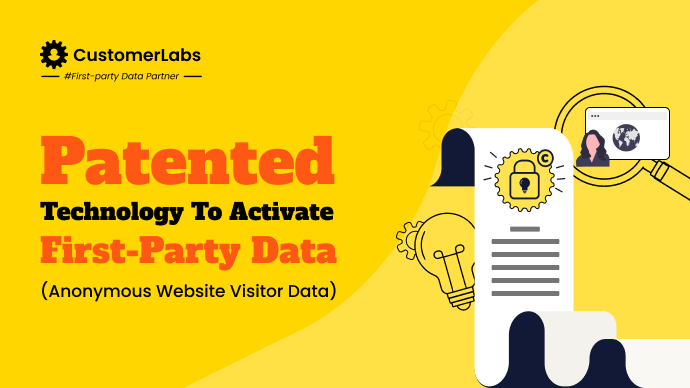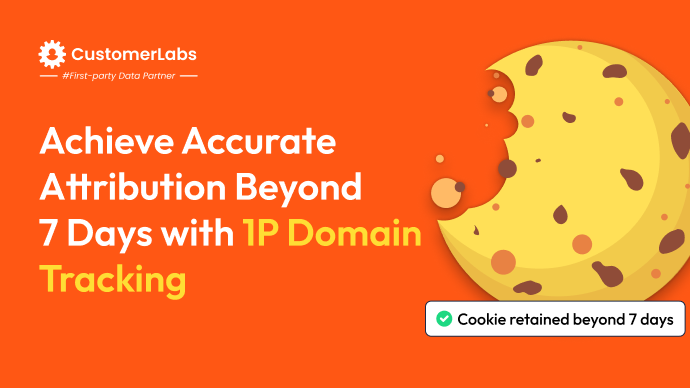If you’re a marketer who takes signal quality seriously, you should definitely know about li_fat_id (Linkedin_first_party_ads_tracking_uuid). When sent along with other user data through LinkedIn Conversions API (CAPI), it is a key parameter that will help improve signal quality and boost ad campaign performance.
Let me walk you through the nitty-gritty of li_fat_id and how to make the best use of it.
First of all, what is li_fat_ID?
Li_fat_id is a unique first-party cookie ID generated by LinkedIn when a user clicks on a LinkedIn ad. It is appended at the end of the landing page URL similar to other click IDs, and stored as a first-party cookie in the user’s browser. If in case you didn’t set up LinkedIn CAPI properly, li_fat_id will be stored as a third-party cookie.
Li_fat_id is one of the crucial parameters that has gained attention for its awesome benefits such as enhancing signal quality, improved match rates, better attribution, and a boost in overall ad campaign performance.
How does li_fat_id help LinkedIn Ads?
Li_fat_id facilitates LinkedIn Ads in a whole bunch of ways. Let me list a few.
1. Accurately identifies the users
Despite some characteristics of li_fat_id being similar to other click IDs like being appended at the end of the landing page URL, it stands out in its “unchanged” nature.
Yes! Li_fat_id does not change with every click like Google click ID and FB click ID. And since it’s unchanged, it can identify the users who have converted more accurately than other Click IDs.
2. Increases customer match rates
When you stream all the first-party data including the li_fat_id parameter through LinkedIn CAPI, LinkedIn can precisely identify the users using li_fat_id which increases your customer match rates.
3. Betters attribution and increases conversion
Li_fat_id helps increase attribution by accurately mapping conversions to specific LinkedIn Ads. This way, you can target similar audiences and use suitable ads to increase overall conversion.
4. Improves retargeting
Li_fat_id remains unchanged across clicks. So, when you send li_fat_id to LinkedIn via CAPI it can accurately identify the users and retarget the ones who have previously engaged with your brand improving retargeting campaign performance.
5. Enhance the signal quality for LinkedIn Ads
When you send high-quality data along with li_fat_id to LinkedIn it improves the signal quality for LinkedIn Ads. The resulting High-quality signals allow LinkedIn’s algorithms to better understand user behavior and ad interactions, leading to more effective ad targeting, campaign optimization, and increased campaign performance.
How li_fat_id works
When a user clicks on a LinkedIn ad and lands on your website page, a li_fat_id is appended at the end of the landing page URL. Simultaneously, LinkedIn will generate a li_fat_id first-party cookie from your own domain and store it in the user’s browser.
However, when CAPI is not properly configured, li_fat_id is stored in a third-party cookie by LinkedIn (a third-party domain).
The li_fat_id is valid for 30 days from the date when the user clicks on the LinkedIn ad. And, despite the lifespan of the ID being 30 days, it remains the same for that particular user.
For instance, let’s say a user clicks on a LinkedIn ad for the first time, a li_fat_id will be generated, and after 30 days the ID will be deleted. And, let’s assume that the same user clicks on a different LinkedIn ad after 30 days, now the same li_fat_id will be generated again for that user.
Now, if you send the generated li_fat_id of the user along with other user data to LinkedIn it will be able to understand that the user resulted in a conversion. This way, LinkedIn can attribute conversions far more accurately than before.
How to leverage Linkedin_first_party_ads_tracking_uuid
To start with, set up LinkedIn Ads for generating li_fat_id
Before knowing how to generate li_fat_id you should get clarity on what the Insight Tag is. Insight Tag is a piece of code from LinkedIn that helps track all events on your website. It sends data from your site to LinkedIn Ads through the browser.
Now to generate li_fat_id, go to Insight Tag settings and check the box near “Enable enhanced conversion tracking”. Once enabled, the li_fat_id will be generated for users and appended at the end of the URL. However, to store the li_fat_id in the cookie as well, you need to set up the Insight Tag on your website.
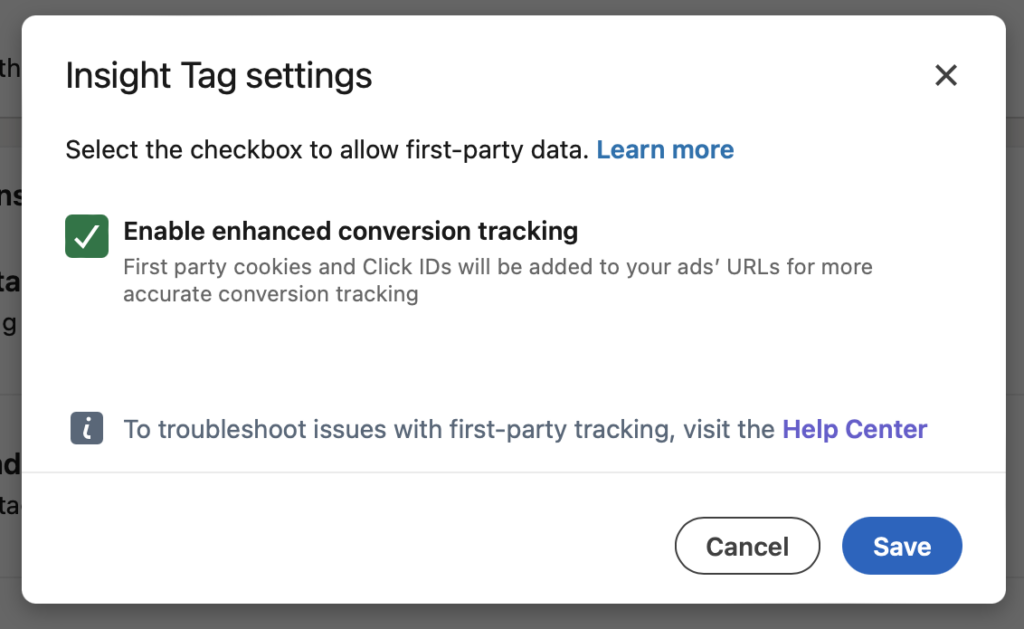
Here’s what happens next, the generated li_fat_id along with other user data will be sent to LinkedIn by Insight Tag. This way, the users who click on LinkedIn Ads will be tracked. Now, LinkedIn can match users accurately back to the ad they clicked on, attribute them to specific conversions, and improve conversion tracking on the browser side.
Note: If you’re setting up LinkedIn Conversions API, make sure the FirstPartyTrackingEnabled parameter is set to true.
Now, there are two scenarios to see which is the right way to leverage the li_fat_id.
Scenario 1: Insight tag not added to the website, and enhanced conversion tracking enabled
Unlike the Facebook pixel, you don’t need to add the Insight Tag to your website. You can just enable the Insight Tag and enhanced conversion tracking in LinkedIn’s Campaign Manager without installing the tag on your site.
Now, in scenario 1,
- Insight Tag is not added to the website, but enhanced conversion tracking is enabled.
- You must create the Insight Tag in LinkedIn Ad Campaign Manager and enable enhanced conversion tracking in the Insight Tags settings. Also, you have to follow the instructions to enable Click IDs.
After setting this up, every time a user clicks on an ad and is redirected to a landing page, the li_fat_id is added to the URL. It is important to note that no cookies are involved here; the li_fat_id is only appended to the landing page URL.
Since the Insight Tag is not installed, view-through conversion tracking will not be available. However, click-through conversions are supported if you set up the Conversions API and send li_fat_id along with user data to LinkedIn Ads. This means that click-through conversions will happen and be attributed to your ad campaigns.
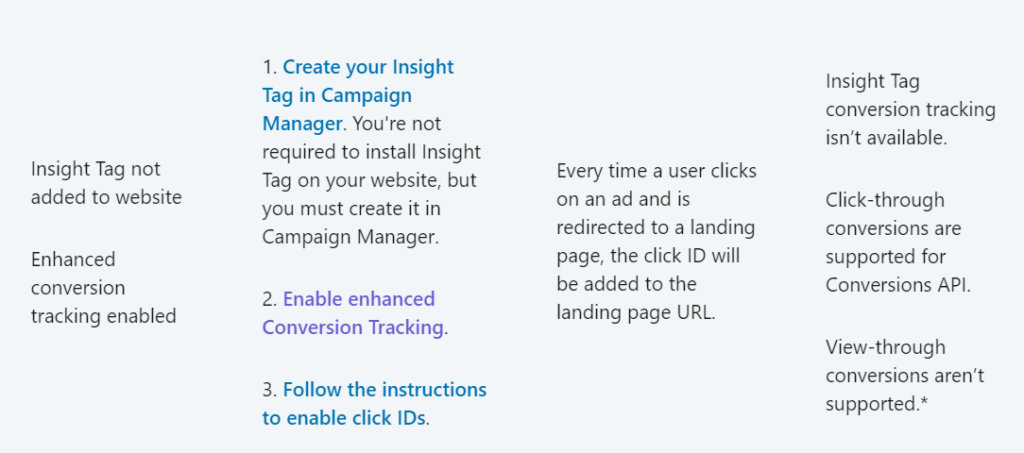
Scenario 2: Insight tag added to the website, and enhanced conversion tracking enabled
In Scenario 2, the Insight Tag is added to your website and enhanced conversion tracking is enabled. Besides you have to follow instructions to enable click IDs.
Now, when a user clicks on an ad, the li_fat_id is appended to the landing page URL and also stored in a cookie on the user’s browser. The cookie storing the li_fat_id is valid for 30 days and the validity period resets with each new click. For example, if a user clicks today, the li_fat_id is stored for 30 days. If they click on any other LinkedIn ad tomorrow, the validity is extended for another 30 days.
Here in this set up both click-through and view-through conversions are supported.
- Click-through conversions are supported by both the Insight Tag installed on your website and the Conversions API.
- View-through conversions are supported by the Insight Tag. Whereas the CAPI supports view-through conversions only if the user previously clicked on another of your ads within the last 30 days and you retrieve the click ID from your cookie store.
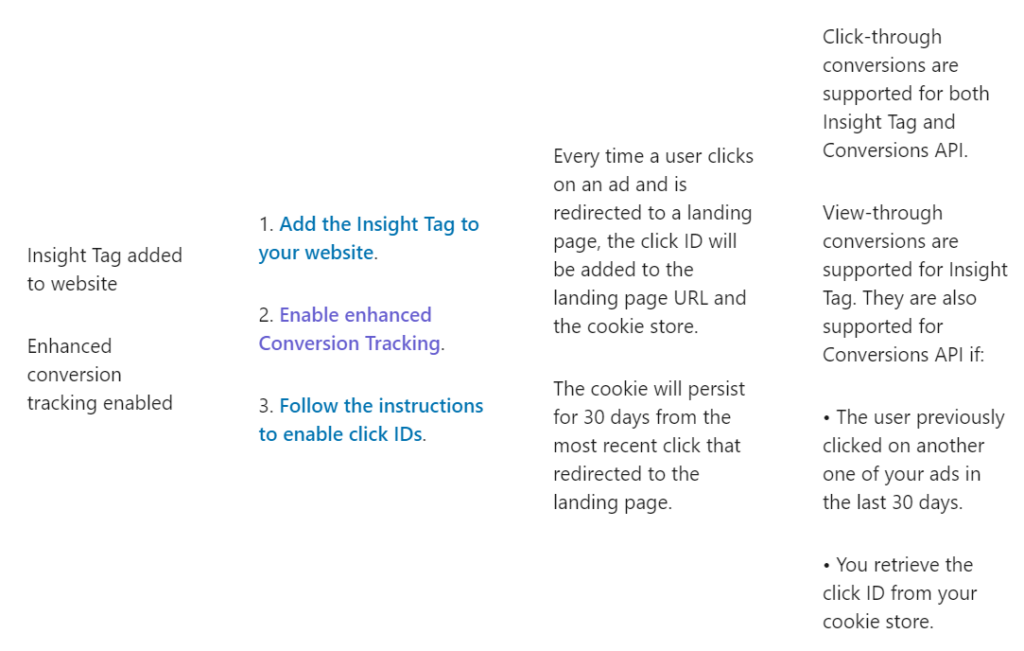
What are the other important parameters to be sent to LinkedIn for better ad performance?
To improve signal quality and enhance ad performance, it is essential to send various user IDs to LinkedIn. While the li_fat_id is a crucial parameter, it should be supplemented with other identifiers such as:
- Hashed email IDs (using SHA-256)
- Axiom ID
- Oracle MOAT ID
- First name
- Last name
- Company name
- Title
- Country code
- LeadGenFormResponseUrns – Generated when a user submits a LinkedIn Lead Gen Form and advertisers can download it.
Sending these parameters to LinkedIn Ads along with li_fat_id helps improve signal quality and increases match rates, leading to better ad campaign performance and more effective retargeting.
Unify user IDs using CustomerLabs
If you want to leverage view-through conversions you have to retrieve li_fat_id from your cookie store and send it back to LinkedIn Ads. To do this, CustomerLabs can help you by storing all the user IDs in a single place and sending them to LinkedIn Ads.
So you can collect all important event parameters along with li_fat_id, store them in CustomerLabs 1PD Ops, and send them to LinkedIn Ads via Conversions API to increase your match rates and make your ad campaign skyrocket.

Final thoughts
Li_fat_id is pretty darn important when it comes to LinkedIn ad campaign performance as its unchanged nature helps in improving signal quality and accurate user identification.
Make the best use of this unique user ID by enabling enhanced conversion tracking and adding Insight Tag to your website. Also, stick to the best practice of setting up LinkedIn Conversions API and sending li_fat_id along with other user data to mitigate signal loss.
